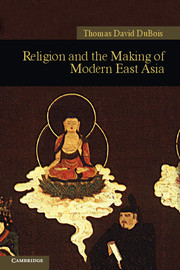Book contents
- Frontmatter
- Contents
- List of Boxes, Figures, and Maps
- Preface
- 1 In the beginning: Religion and history
- 2 Ming China: The fourteenth century's new world order
- 3 The Buddha and the shōgun in sixteenth-century Japan
- 4 Opportunities lost: The failure of Christianity, 1550–1750
- 5 Buddhism: Incarnations and reincarnations
- 6 Apocalypse now
- 7 Out of the twilight: Religion and the late nineteenth century
- 8 Into the abyss: Religion and the road to disaster during the early twentieth century
- 9 Brave new world: Religion in the reinvention of postwar Asia
- 10 The globalization of Asian religion
- Glossary
- Timeline of dynasties and major events
- Suggestions for further reading
- Index
10 - The globalization of Asian religion
Published online by Cambridge University Press: 05 June 2012
- Frontmatter
- Contents
- List of Boxes, Figures, and Maps
- Preface
- 1 In the beginning: Religion and history
- 2 Ming China: The fourteenth century's new world order
- 3 The Buddha and the shōgun in sixteenth-century Japan
- 4 Opportunities lost: The failure of Christianity, 1550–1750
- 5 Buddhism: Incarnations and reincarnations
- 6 Apocalypse now
- 7 Out of the twilight: Religion and the late nineteenth century
- 8 Into the abyss: Religion and the road to disaster during the early twentieth century
- 9 Brave new world: Religion in the reinvention of postwar Asia
- 10 The globalization of Asian religion
- Glossary
- Timeline of dynasties and major events
- Suggestions for further reading
- Index
Summary
Let us especially cease calling the Emperor of China, and the souban of the Deccan idolaters.… I must repeat, the religion of their learned is admirable, and free from superstitions, from absurd legends, from dogmas insulting both to reason and to nature.
Voltaire, A Philosophical Dictionary, 269–70It would be hard to point to a precise moment when the world became “global.” After all, people have been communicating on a global scale for tens of thousands of years – the fact that early humans managed to travel from Africa through Eurasia and settle the Americas and Australia represents globalization of a rather profound sort. Of course, the pace of communication started out very slow indeed. Even a very good idea, such as the domestication of the horse, probably took a thousand years to reach all corners of Europe and Asia. Political integration advanced the flow of ideas. When the Roman Empire connected much of Europe and the Mediterranean, it also created a cultural world that was linked by technologies, language, and eventually Christianity. The last great frontiers were the oceans: the New World did not have horses or Christianity (or smallpox, for that matter) until the Spanish introduced them in the late fifteenth century. Over the past century, however, the rate of global communication has advanced exponentially. New communications technologies are one obvious reason. To appreciate the pace of change, try taking the big innovations and working backward.
- Type
- Chapter
- Information
- Religion and the Making of Modern East Asia , pp. 224 - 230Publisher: Cambridge University PressPrint publication year: 2011

